Related Research Articles
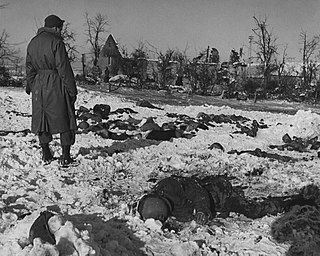
A war crime is a violation of the laws of war that gives rise to individual criminal responsibility for actions by combatants in action, such as intentionally killing civilians or intentionally killing prisoners of war, torture, taking hostages, unnecessarily destroying civilian property, deception by perfidy, wartime sexual violence, pillaging, and for any individual that is part of the command structure who orders any attempt to committing mass killings including genocide or ethnic cleansing, the granting of no quarter despite surrender, the conscription of children in the military and flouting the legal distinctions of proportionality and military necessity.

Psychological warfare (PSYWAR), or the basic aspects of modern psychological operations (PsyOp), have been known by many other names or terms, including Military Information Support Operations (MISO), Psy Ops, political warfare, "Hearts and Minds", and propaganda. The term is used "to denote any action which is practiced mainly by psychological methods with the aim of evoking a planned psychological reaction in other people".
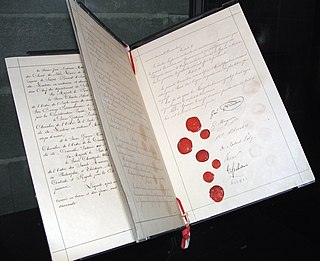
The law of war is the component of international law that regulates the conditions for initiating war and the conduct of warring parties. Laws of war define sovereignty and nationhood, states and territories, occupation, and other critical terms of law.

Operation Bodyguard was the code name for a World War II deception strategy employed by the Allied states before the 1944 invasion of northwest Europe. Bodyguard set out an overall stratagem for misleading the Oberkommando der Wehrmacht as to the time and place of the invasion. Planning for Bodyguard was started in 1943 by the London Controlling Section, a department of the war cabinet. They produced a draft strategy, referred to as Plan Jael, which was presented to leaders at the Tehran Conference in late November and, despite skepticism due to the failure of earlier deception strategy, approved on 6 December 1943.

White flags have had different meanings throughout history and depending on the locale.
The Thirty-Six Stratagems is a Chinese essay used to illustrate a series of stratagems used in politics, war, and civil interaction.

A summary execution is an execution in which a person is accused of a crime and immediately killed without the benefit of a full and fair trial. Executions as the result of summary justice are sometimes included, but the term generally refers to capture, accusation, and execution all conducted within a very short period of time, and without any trial. Under international law, refusal to accept lawful surrender in combat and instead killing the person surrendering is also categorized as a summary execution.
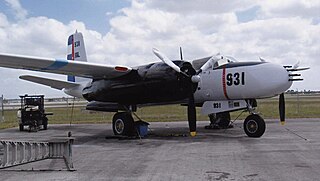
A false flag operation is an act committed with the intent of disguising the actual source of responsibility and pinning blame on another party. The term "false flag" originated in the 16th century as an expression meaning an intentional misrepresentation of someone's allegiance. The term was famously used to describe a ruse in naval warfare whereby a vessel flew the flag of a neutral or enemy country in order to hide its true identity. The tactic was originally used by pirates and privateers to deceive other ships into allowing them to move closer before attacking them. It later was deemed an acceptable practice during naval warfare according to international maritime laws, provided the attacking vessel displayed its true flag once an attack had begun.

A Quaker gun is a deception tactic that was commonly used in warfare during the 18th and 19th centuries. Although resembling an actual cannon, the Quaker gun was simply a wooden log, usually painted black, used to deceive an enemy. Misleading the enemy as to the strength of an emplacement was an effective delaying tactic. The name derives from the Religious Society of Friends or "Quakers", who have traditionally held a religious opposition to war and violence in the Peace Testimony.

Surrender, in military terms, is the relinquishment of control over territory, combatants, fortifications, ships or armament to another power. A surrender may be accomplished peacefully or it may be the result of defeat in battle. A sovereign state may surrender following defeat in a war, usually by signing a peace treaty or capitulation agreement. A battlefield surrender, either by individuals or when ordered by officers, normally results in those surrendering becoming prisoners of war.
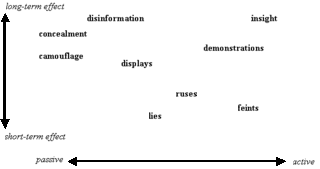
Military deception (MILDEC) is an attempt by a military unit to gain an advantage during warfare by misleading adversary decision makers into taking action or inaction that creates favorable conditions for the deceiving force. This is usually achieved by creating or amplifying an artificial fog of war via psychological operations, information warfare, visual deception, or other methods. As a form of disinformation, it overlaps with psychological warfare. Military deception is also closely connected to operations security (OPSEC) in that OPSEC attempts to conceal from the adversary critical information about an organization's capabilities, activities, limitations, and intentions, or provide a plausible alternate explanation for the details the adversary can observe, while deception reveals false information in an effort to mislead the adversary.

Military camouflage is the use of camouflage by an armed force to protect personnel and equipment from observation by enemy forces. In practice, this means applying colour and materials to military equipment of all kinds, including vehicles, ships, aircraft, gun positions and battledress, either to conceal it from observation (crypsis), or to make it appear as something else (mimicry). The French slang word camouflage came into common English usage during World War I when the concept of visual deception developed into an essential part of modern military tactics. In that war, long-range artillery and observation from the air combined to expand the field of fire, and camouflage was widely used to decrease the danger of being targeted or to enable surprise. As such, military camouflage is a form of military deception in addition to cultural functions such as political identification.
In the context of war, perfidy is a form of deception in which one side promises to act in good faith with the intention of breaking that promise once the unsuspecting enemy is exposed.

Dummies and decoys are fake military equipment that are intended to deceive the enemy. Dummies and decoys are only one aspect of military deception.
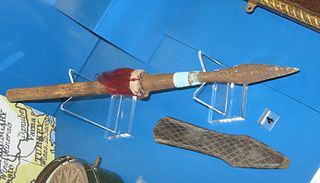
A prize of war is a piece of enemy property or land seized by a belligerent party during or after a war or battle, typically at sea. This term was used nearly exclusively in terms of captured ships during the 18th and 19th centuries.
Russian military deception, sometimes known as maskirovka, is a military doctrine developed from the start of the 20th century. The doctrine covers a broad range of measures for military deception, from camouflage to denial and deception.

The Ghost Army was a United States Army tactical deception unit during World War II officially known as the 23rd Headquarters Special Troops. The 1100-man unit was given a unique mission: to deceive Hitler's forces and mislead them as to the size and location of Allied forces, while giving the actual units elsewhere time to maneuver. Activated on January 20, 1944, the Ghost Army arrived in Europe in May shortly before D-Day and returned to the US at the end of the war in July 1945. During their tenure, the Ghost Army carried out more than 20 deception campaigns, putting on a "traveling road show" using inflatable tanks, sound trucks, fake radio transmissions, scripts and pretense.
Operation Greif was a special operation commanded by Waffen-SS commando Otto Skorzeny during the Battle of the Bulge in World War II. The operation was the brainchild of Adolf Hitler, and its purpose was to capture one or more of the bridges over the Meuse river before they could be destroyed. German soldiers, wearing captured British and U.S. Army uniforms and using captured Allied vehicles, were to cause confusion in the rear of the Allied lines. A lack of vehicles, uniforms and equipment limited the operation and it never achieved its original aim of securing the Meuse bridges. Skorzeny's post-war trial set a precedent clarifying article 4 of the Geneva Convention: as the German soldiers removed the Allied uniforms before engaging in combat, they were not to be considered francs-tireurs.

Lieutenant Colonel Victor Harry Jones OBE was a British intelligence officer and "visual deception" expert during the Second World War. First serving with the 14th/20th King's Hussars in the First World War, he made a name for himself during the North African campaign of the Second World War by using dummy tanks to mislead the enemy. In 1941 he was transferred to A Force in Cairo, under Dudley Clarke, to continue deception operations on a larger scale.
References
This article needs additional citations for verification .(September 2011) |
- ↑ Matuszczyk, A. (2012). Creative Stratagems: Creative and Systems Thinking in Handling Social Conflict. Kibworth/GB: Modern Society Publishing. (p. 21)
- ↑ Charles Rollin. "Ancient Carthage". history-world.org. Archived from the original on November 27, 2005. Retrieved December 3, 2011.
{{cite web}}: CS1 maint: unfit URL (link) - 1 2 3 Coles, Harry L. (1966). The War of 1812. University of Chicago Press. pp. 51–53. ISBN 978-0-2261-1350-0.
- ↑ Merritt, in Wood, William ed. Select British Documents of the Canadian War of 1812. British documents, 3:554.)
- ↑ Tucker, Spencer T. (2009). A Global Chronology of Conflict: From the Ancient World to the Modern Middle East. ABC-CLIO. p. 1107. ISBN 978-1-8510-9672-5.
- ↑ Elting, John R. (1995). Amateurs to Arms: A military history of the War of 1812 . New York: Da Capo Press. p. 147. ISBN 978-0-3068-0653-7.
- ↑ Staff. "FROM CITY POINT.; Gen. Meade's Order Correction A Ruse de Guerre Coming Events Ominous Clouds Gathering.", The New York Times , March 31, 1865. Retrieved October 3, 2008.
- ↑ "Japanese Ruse That Failed.; Togo Tried to Make Believe He Was Chasing Vladivostok Squadron". The New York Times . April 24, 1904. Retrieved October 3, 2008.
- ↑ "Washington Officials Silent; Lusitania Use of Flag Denounced in the House". The New York Times. February 9, 1915. Retrieved October 3, 2008.
- ↑ "Court Holds Former SS Officer and Seven Aides Did Not Violate the Rules of War During Battle of Bulge". The New York Times. September 10, 1947. Retrieved October 3, 2008.
- 1 2 3 "United States of America, Practice Relating to Rule 57. Ruses of War". International Committee of the Red Cross.
- ↑ "Treaties, States parties, and Commentaries – CCW Protocol (II) prohibiting Mines, Booby-Traps and Other Devices, 1980".
- ↑ "Convention (IV) respecting the Laws and Customs of War on Land and its annex: Regulations concerning the Laws and Customs of War on Land. The Hague, 18 October 1907". International Committee of the Red Cross.
- ↑ "United States of America, Practice Relating to Rule 65. Perfidy, Section D. Simulation of surrender". International Committee of the Red Cross.
- ↑ "United States of America, Practice Relating to Rule 64. Conclusion of an Agreement to Suspend Combat with the Intention of Attacking by Surprise the Adversary Relying on It". International Committee of the Red Cross.
- ↑ "United States v. Hagendorf, Judgment, N/A (U.S. Intermed. Gov. Ct. (Dachau, Germany), Aug. 09, 1946)". www.worldcourts.com. Retrieved 2022-10-04.